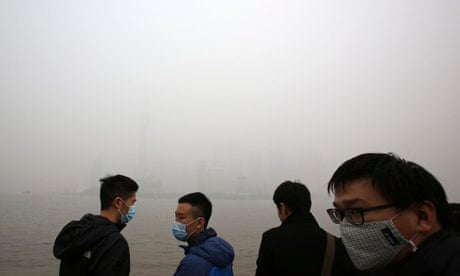China's air pollution in 2013 is at its worst for some 52 years, with 13 provinces hitting record-high levels of air pollution, according to the ministry of environmental protection. In recent days, traffic has been delayed in Shanghai, Jiangsu, Henan, Shandong; construction projects suspended in Wuhan City; and schools closed in several cities, including Shanghai.
Nearly half of China has been hit by smog, with the southeastern regions experiencing severe conditions.
Authorities have found it difficult to tackle pollution, but recognising the scale of the challenge, governments, laboratories and universities in China are now working intensively and collaboratively to better understand sources of air pollution and how they are dispersed or concentrated in the atmosphere.
The country's five-year action plan has provisons to improve environment technology, planning and regulation. Its focus is on "air pollution control led by government, enforced by companies, driven by market and participated in by the public". It emphasises on making polluters pay and rewarding energy efficiency, conservation and emissions reduction efforts. The plan also aims at reducing heavy pollution by a large margin and improve air quality in Beijing-Tianjin-Hebei province, the Yangtze River Delta and the Pearl River Delta.
Currently the public and private sector use computer models to simulate how emissions from transportation, power plants and industry affect the atmosphere. This information is then used to determine levels of concentration of toxic gases and particles at street level.
Increasingly, more cities are now monitoring air quality in real time using meteorological towers and remote sensing from satellites to track pollutants. In Beijing concentrations of micro particles in the atmosphere have been found to be more than 10 times the safe level recommended by the WHO. This has prompted authorities to take measures such as limiting industrial emissions and reducing traffic across the nation.
In Shenzhen and Guangzhou air pollution levels are now decreasing after peaking in 2007. Air quality in Shanghai is also recognised as better than in Beijing. In part, this is because Shanghai now has strict regulations for ships entering its harbours and has advised that vessels should both switch to cleaner fuels when they are about 100 miles away, and make use of electrical power when they have docked.
But even in these cities the haze is so thick that often in winter it blocks out the sun, reducing natural light and warmth significantly. As a result temperature drops, households use more energy for heating; pollution gets worse, causing respiratory diseases and eventually more people are hospitalised.
However, improvements could be made with more data becoming accessible and fed into simulation models to provide accurate assessments of how changes to transportation, industry and power plants and even agricultural practice could help to reduce pollution. Dust and pollution concentrations can also be reduced by better overall planning, including size and type of economic activity, designs of buildings, roadways and green spaces.
China is also applying existing technologies more extensively. This is resulting in cleaner emissions from power stations, replacement of coal-power heating systems with electric and gas-fired systems, and bio-processing of agricultural waste (rather than burning which adds to pollution). The government's aim is to reduce the country's coal consumption to below 65% by 2017.
The country is also taking up affordable battery-driven cycles, priced at $200.
In the near future, roadside detectors will be able to monitor emissions from individual cars. Already, trams and buses with monitors are able to survey street pollution more thoroughly.
Air pollution can also be forecast a few days ahead, even on a street by street basis, by using models of how traffic and atmosphere are likely to change. This will help tourists, cyclists and others to avoid polluted areas.
Smart traffic systems to lessen congestion on roads are also being considered. These are already being trialled in Singapore.
Air pollution continue to pose a serious health risk in China but efforts are underway to clean up the air. The government has set up special funds to subsidise environmental-friendly industries, it is improving policies on pricing and taxation and encouraging private funds to invest in air pollution control technology. There are also plans to rank air quality of key cities regularly and establish mandatory environmental information disclosure system for companies causing heavy pollution.
Lord Hunt is visiting professor at Delft University and the University of Hong Kong. Professor Jimmy Fung is head of the Division of Environment at the University of Hong Kong
This content is brought to you by Guardian Professional. To get more articles like this direct to your inbox, sign up free to become a member of the Global Development Professionals Network

Comments (…)
Sign in or create your Guardian account to join the discussion